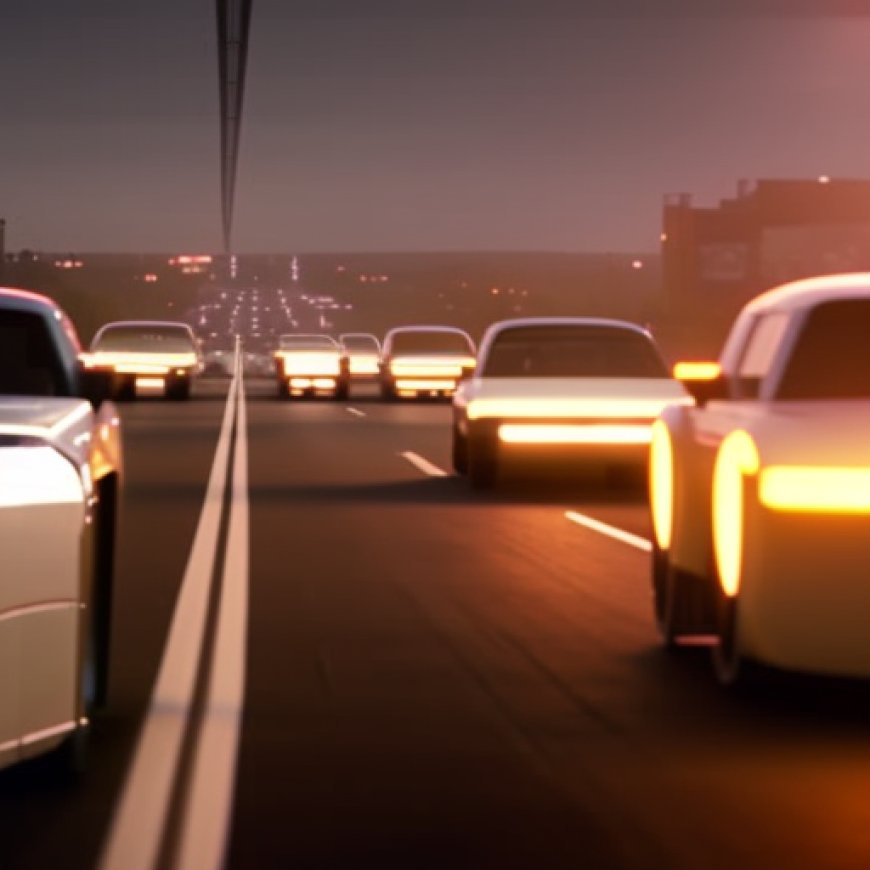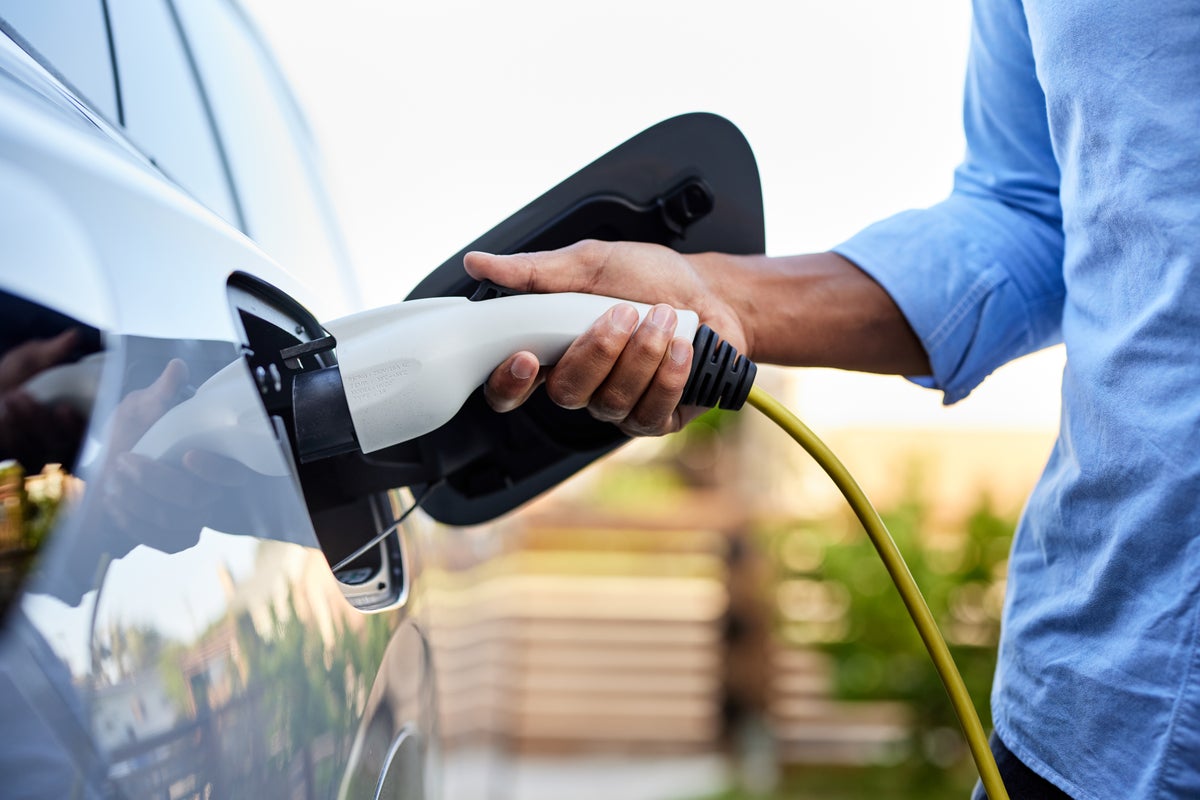The Future of Driving in the U.S. Is Electric—Sort Of
The Future of Driving in the U.S. Is Electric—Sort Of Scientific American



CLIMATEWIRE
The Biden administration’s plan to electrify the car industry will get a little help from gasoline engines.
EPA’s original proposal to control greenhouse gas emissions from light-duty vehicles estimated that 67 percent of new passenger car sales would need to be electric in eight years.
The final version released Wednesday still leans on fully electric vehicles, but it makes room for plug-in hybrids and other types of cars that run on gas. EPA estimates that 56 percent of cars and light trucks will be fully electric by 2032 and 13 percent will be plug-in hybrids — which use a combination of batteries and gas. Other scenarios outlined by the agency show as few as 35 percent of sales being fully electric cars, along with 36 percent being plug-in hybrids. (The remainder would be internal combustion vehicles or hybrids without a plug-in option).
On supporting science journalism
If you’re enjoying this article, consider supporting our award-winning journalism by subscribing. By purchasing a subscription you are helping to ensure the future of impactful stories about the discoveries and ideas shaping our world today.
Carmakers and EPA Administrator Michael Regan hailed the change as a practical move that will lead to drastic cuts in climate-warming pollution, while giving the industry the flexibility it needs to adapt. And they say it would protect the rule against political and legal challenges, which have already been set in motion.
“When you look at the total picture, we are not sacrificing environmental integrity,” Regan said Wednesday in announcing the rule. “We believe it makes a stronger rule, a more durable rule.”
It’s also a tacit acknowledgment that a lot of car buyers — apart from early EV adopters — will need time to absorb the change that’s pulling into their driveways.
It will take a while for manufacturers to produce the variety of vehicles people want and for people to get used to using cords instead of pumps, said Stephanie Brinley, an auto analyst at S&P Global Mobility.
“It’s going to go at a consumer’s pace more than at a regulator’s path,” she said.
At the same time, relying on plug-in hybrids injects uncertainty into the EPA rule. They typically have a limited electric range, and they use conventional engines for longer trips. So the amount of pollution they create will depend on the driving habits of millions of drivers — some of whom may decide not to use the batteries.
“If you don’t plug it in, you’re running on gas,” said Dan Becker, director of the safe climate campaign at the Center for Biological Diversity. And many plug-in hybrids are inefficient SUVs and minivans that begin sucking gas after using a spurt of electricity.
The rule change is a win for conventional carmakers like General Motors and Toyota, both of which have said they plan to lean on plug-in hybrids in the near future.
GM Chief Executive Mary Barra said in January that the company still plans to eliminate emissions from its light-duty vehicles by 2035, “but in the interim, deploying plug-in technology in strategic segments will deliver some of the environmental benefits of EVs as the nation continues to build its charging infrastructure.”
GM’s share price jumped a little more than 3 percent Wednesday.
A spokesperson for GM declined to comment, saying the company was still studying the EPA rule. But the Alliance for Automotive Innovation, a trade group, was upbeat about the changes.
“I think this final rule recognizes the importance of consumers. And that ultimately, consumers are in the driver’s seat,” John Bozzella, the group’s chief executive, said in a statement.
The rule covers vehicles built in model years 2027 through 2032. It doesn’t dictate what kind of engines carmakers can use but sets a limit on emissions of carbon dioxide and other types of pollution.
EPA originally focused the regulation on supporting battery-electric vehicles, under the assumption that they were the lowest-cost way to cut emissions from new cars. But after pushback from manufacturers, dealers and labor groups, the agency took a new look at plug-in hybrids, a senior administration official told reporters.
“So in this final rule, we identified a much more robust option for using plug-in electrics or marketing plug-in hybrid electrics along with battery electrics as an option,” said the official, who declined to be named citing White House rules.
The final rule also eased the timeline for the car industry, pushing the steepest emissions cuts to the last few years of the regulated period.
It still aims to cut climate pollution from cars 50 percent by 2032 and would prevent more than 7 billion tons of carbon emissions by 2055.
“So when you look at 2027 through 2032, the flexibilities that we provided ensured that we get more uptake of clean energy vehicles for the long haul, while preserving that environmental integrity in terms of the goals that we set,” Regan said.
Even after EPA eased the path for car companies, they still face difficult choices, said John Helveston, a professor at George Washington University who studies transportation trends. Consumers may prefer hybrid cars in the short term, but car companies will have to balance that against the falling price of electric vehicles and rising competition from low-priced EVs manufactured in Asia.
“There’s some long-term decisionmaking these companies need to think about, and they need to be thinking seriously about the competition coming from abroad,” he said.
This story also appears in Energywire.
Reprinted from E&E News
SDGs, Targets, and Indicators
| SDGs | Targets | Indicators |
|---|---|---|
| SDG 7: Affordable and Clean Energy | Target 7.2: By 2030, increase substantially the share of renewable energy in the global energy mix | – No specific indicators mentioned in the article |
| SDG 9: Industry, Innovation, and Infrastructure | Target 9.4: Upgrade infrastructure and retrofit industries to make them sustainable, with increased resource-use efficiency and greater adoption of clean and environmentally sound technologies and industrial processes | – No specific indicators mentioned in the article |
| SDG 11: Sustainable Cities and Communities | Target 11.6: By 2030, reduce the adverse per capita environmental impact of cities, including by paying special attention to air quality and municipal and other waste management | – No specific indicators mentioned in the article |
| SDG 13: Climate Action | Target 13.2: Integrate climate change measures into national policies, strategies, and planning | – No specific indicators mentioned in the article |
| SDG 17: Partnerships for the Goals | Target 17.17: Encourage and promote effective public, public-private, and civil society partnerships, building on the experience and resourcing strategies of partnerships | – No specific indicators mentioned in the article |
1. Which SDGs are addressed or connected to the issues highlighted in the article?
- SDG 7: Affordable and Clean Energy
- SDG 9: Industry, Innovation, and Infrastructure
- SDG 11: Sustainable Cities and Communities
- SDG 13: Climate Action
- SDG 17: Partnerships for the Goals
2. What specific targets under those SDGs can be identified based on the article’s content?
- Target 7.2: By 2030, increase substantially the share of renewable energy in the global energy mix
- Target 9.4: Upgrade infrastructure and retrofit industries to make them sustainable, with increased resource-use efficiency and greater adoption of clean and environmentally sound technologies and industrial processes
- Target 11.6: By 2030, reduce the adverse per capita environmental impact of cities, including by paying special attention to air quality and municipal and other waste management
- Target 13.2: Integrate climate change measures into national policies, strategies, and planning
- Target 17.17: Encourage and promote effective public, public-private, and civil society partnerships, building on the experience and resourcing strategies of partnerships
3. Are there any indicators mentioned or implied in the article that can be used to measure progress towards the identified targets?
No, the article does not mention any specific indicators that can be used to measure progress towards the identified targets.
4. Create a table with three columns titled ‘SDGs, Targets and Indicators” to present the findings from analyzing the article. In this table, list the Sustainable Development Goals (SDGs), their corresponding targets, and the specific indicators identified in the article.
| SDGs | Targets | Indicators |
|---|---|---|
| SDG 7: Affordable and Clean Energy | Target 7.2: By 2030, increase substantially the share of renewable energy in the global energy mix | No specific indicators mentioned in the article |
| SDG 9: Industry, Innovation, and Infrastructure | Target 9.4: Upgrade infrastructure and retrofit industries to make them sustainable, with increased resource-use efficiency and greater adoption of clean and environmentally sound technologies and industrial processes | No specific indicators mentioned in the article |
| SDG 11: Sustainable Cities and Communities | Target 11.6: By 2030, reduce the adverse per capita environmental impact of cities, including by paying special attention to air quality and municipal and other waste management | No specific indicators mentioned in the article |
| SDG 13: Climate Action | Target 13.2: Integrate climate change measures into national policies, strategies, and planning | No specific indicators mentioned in the article |
| SDG 17: Partnerships for the Goals | Target 17.17: Encourage and promote effective public, public-private, and civil society partnerships, building on the experience and resourcing strategies of partnerships | No specific indicators mentioned in the article |
Behold! This splendid article springs forth from the wellspring of knowledge, shaped by a wondrous proprietary AI technology that delved into a vast ocean of data, illuminating the path towards the Sustainable Development Goals. Remember that all rights are reserved by SDG Investors LLC, empowering us to champion progress together.
Source: scientificamerican.com

Join us, as fellow seekers of change, on a transformative journey at https://sdgtalks.ai/welcome, where you can become a member and actively contribute to shaping a brighter future.







